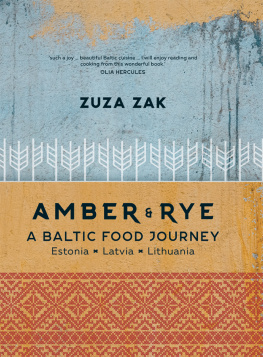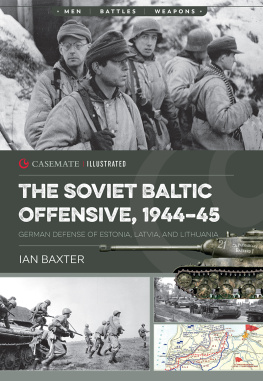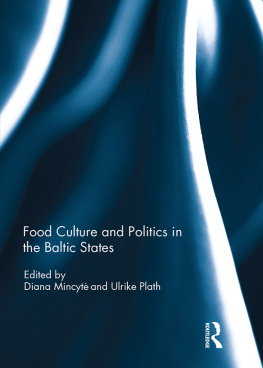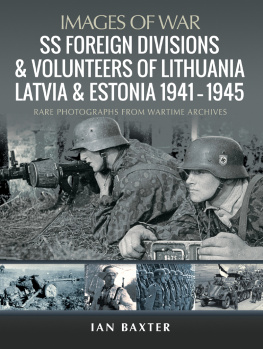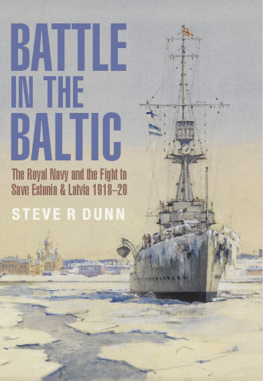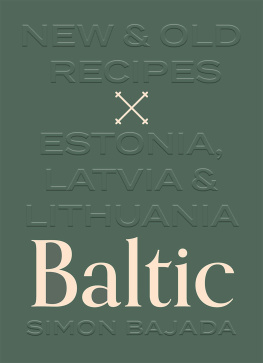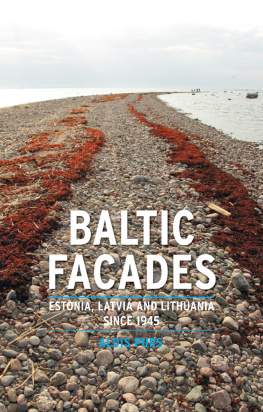In the Baltics, two worlds meet: the Baltic Sea connects Eastern Europe and Scandinavia, bringing with it cultural exchange and culinary influences. All three Baltic capitals, Tallinn, Riga and Vilnius, are UNESCO World Heritage Sites, steeped in history and culture.
Amber & Rye explores this exciting part of Eastern Europe, guiding you around the capitals, sharing stories from the locals, and discovering a dynamic, new style of cooking. Contextualised within the Baltics rich history and culture, this food journey is a doorway to a deeper understanding of what makes the region tick.
The recipes in this book explore new culinary horizons grounded in Baltic traditions yet inspired by contemporary trends making them modern, unique and easy to recreate at home. In addition to the food and stories of travel, there are snippets of poetry, literature, songs and proverbs, adding a rich layer of context that makes Amber & Rye a cultural reference point for travellers as well as a showcase for the vibrant new cuisine of the Baltic States.
a beautiful portrait of the region its landscape, its history, its people and of course its food. Ranging from familiar Sovietera classics to unique regional and modern gems, the recipes are versatile, exciting, inviting and full of flavour. This book is a real highlight within the culinary travelogue genre.
ALISSA TIMOSHKINA, SALT & TIME
Praise for Amber + Rye
It is such a joy to finally see a cookbook on beautiful Baltic cuisine, done with so much sensitivity and respect by Zuza Zak, one of my favourite authors. It is making me pine to travel to the region more than ever. Before I can do that, I will enjoy reading and cooking from this wonderful book.
OLIA HERCULES, SUMMER KITCHENS
Beautifully written and thoroughly researched, Zuza Zaks new book offers a warmly personal insight into a vibrant cuisine of the little-known region of the Baltic states. Zuzas passion for the history, the folklore and the cuisine shines through, making Amber & Rye more than just a recipe book. It is a beautiful portrait of the region its landscape, its history, its people and of course its food. Ranging from familiar Soviet-era classics to unique regional and modern gems, the recipes are versatile, exciting, inviting and full of flavour. This book is a real highlight within the culinary travelogue genre!
ALISSA TIMOSHKINA, SALT & TIME: RECIPES FROM A RUSSIAN KITCHEN
Zuza has an enchanting way with recipe names and her flavour combinations are irresistible. Chanterelles & blueberries, Fermented beetroot elixir, Kajas sour milk lady with berries, Kama yoghurt with plum butter. This is food to fit with the fairytale landscapes the book describes.
ELEANOR FORD, FIRE ISLANDS
Zuza Zak deftly steers us from place to plate though the Baltic trisect of countries, Estonia, Latvia and Lithuania, in her illuminating Amber & Rye, a cookbook brimming with approachable recipes and mouth-watering photographs.
CAROLINE EDEN, BLACK SEA
Zuza Zak is truly the best ambassador for Eastern European culture and cuisine. This book is full of reach-in-and-grab photographs of both food on plates, but also recognisable ingredients full of nostalgia and toska. Theres a sense of abundance and generosity in Zuzas writing, her storytelling and in the food itself. This book is as much a travellers guide as it is a cooks compendium of Baltic cuisine.
ALICE ZASLAVSKY, IN PRAISE OF VEG
Honeycombs, rye ears, rue, tulips and lilies.
Lazy, sweet-toothed bears. Pine resin golden amber,
Baltic foam slowly dissolving into the amber sand.
FROM WHITE SHROUD, BY ANTANAS KMA
For my daughters
contents
My Baltic Odyssey
It all began, as adventures often do, with a story. When I was growing up in Warsaw, my Grandma Halinka would talk endlessly about her idyllic childhood in Lithuania. In painstaking detail, Halinka described to me the dreamy days of her youth, the places she loved in and around Vilnius and the people who lived there. She brought it all so vividly to life that I sometimes felt as if Id been there with her, and would ask her to remind me of some person or detail Id forgotten, or just wanted to hear about again. Her polished mahogany wardrobe, filled to the brim with shiny brooches, leather gloves, multicoloured scarfs and golden-hued amber necklaces was like a secret doorway to that enchanted world of my imagination.
Halinka belonged to an entire generation in exile, people from the Kresy strip of Poland (the borderlands that became Soviet territory after World War II) who were destined to spend their lives pining for the lost lands of their youth.
Then, a couple of years ago, my dad was given a DNA test as a Christmas present, and the results revealed him to be half-Balt, half-Polish. As my grandmother came from Lithuania, this may not seem so surprising; however, she had always maintained that her family were of exclusively Polish heritage. Perplexed, I decided to delve deeper, and discovered that many people who identified as Poles living in Lithuania were in fact ethnically Lithuanian and therefore Balt. For many years a Gente lituanus , natione polonus (Lithuanian tribe, Polish nation) mentality had prevailed, meaning that despite being deeply connected to Lithuania, people like my grandmother considered themselves to be Polish. Perhaps this explained her pain at being separated from not only the land of her childhood but also that of her ancestors.
The Polish Baltic coast of my own childhood memories was a feast for the senses: long walks through shady forests heady with the scent of pines (still to this day my favourite smell) before emerging into the blinding light of white, icing-sugar-soft sand underfoot. Jumping in the frothy waves translucent and freezing, rarely calm. Since the coastline was so far from my home in Warsaw, we did not go there often, and as a result, it became engraved on my memory. Food took on a special significance in this setting. There was the daily pilgrimage to a beach shack usually a concrete block in Eastern Europe for fish soup; tubes of rich, sweet condensed milk to suck on (just as a snack!); waffles covered in fluffy whipped cream; overflowing ice-cream cones at sunset; and evenings brought sausages sizzling over a fire on the beach.
An urge to get to know more of this magical coastline, together with my recently discovered genetic link with the Baltics, prompted me to explore further.
A BRIEF BALTIC HISTORY
Initially used in the Germanic languages as a collective name for the countries fringing the Baltic Sea, the modern term Baltic States was coined to reflect the new-found independence of Estonia, Latvia and Lithuania after World War II. Although these countries have similarities that bring them together, there are also notable differences. And if language reflects our perspective on the world, then Baltic mindsets must be quite distinct from one another. While Lithuanian is among the oldest languages in the world, comparable to Sanskrit and ancient Greek (some say its made for poetry), Latvian has undergone rapid development and modernisation (like English, its constantly changing). Estonian, meanwhile, is closer to Finnish than it is to the languages of its Baltic neighbours.

